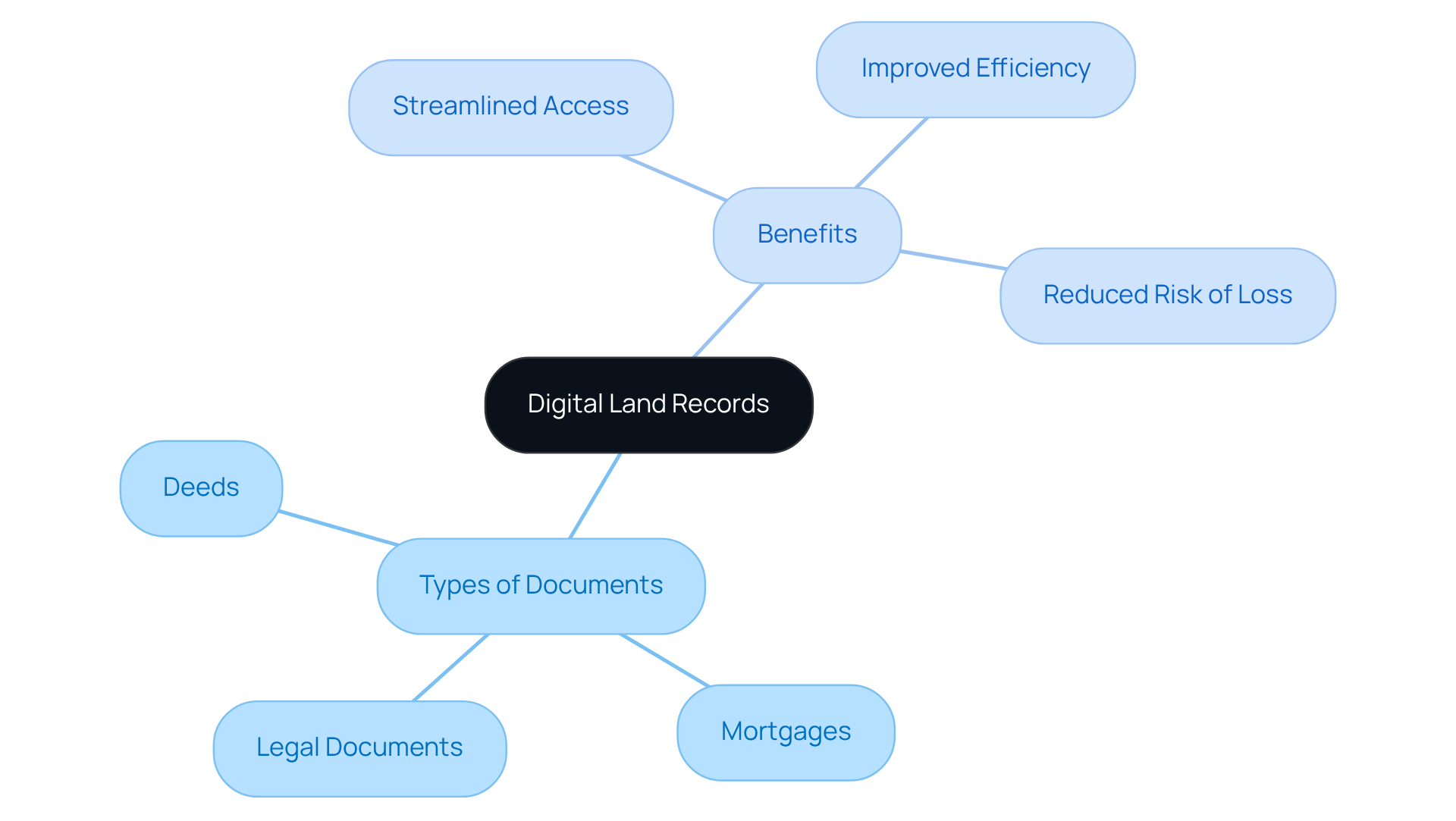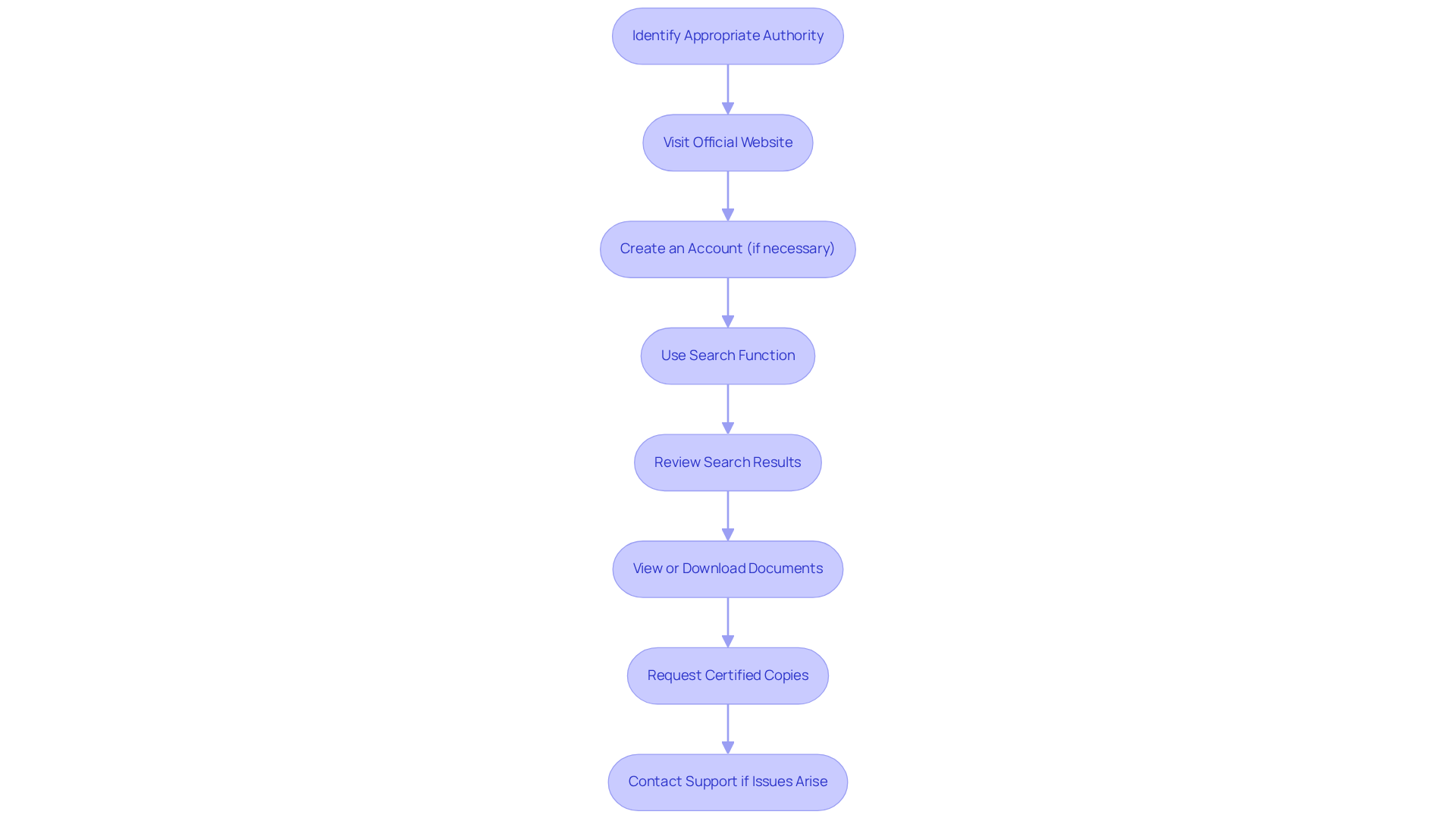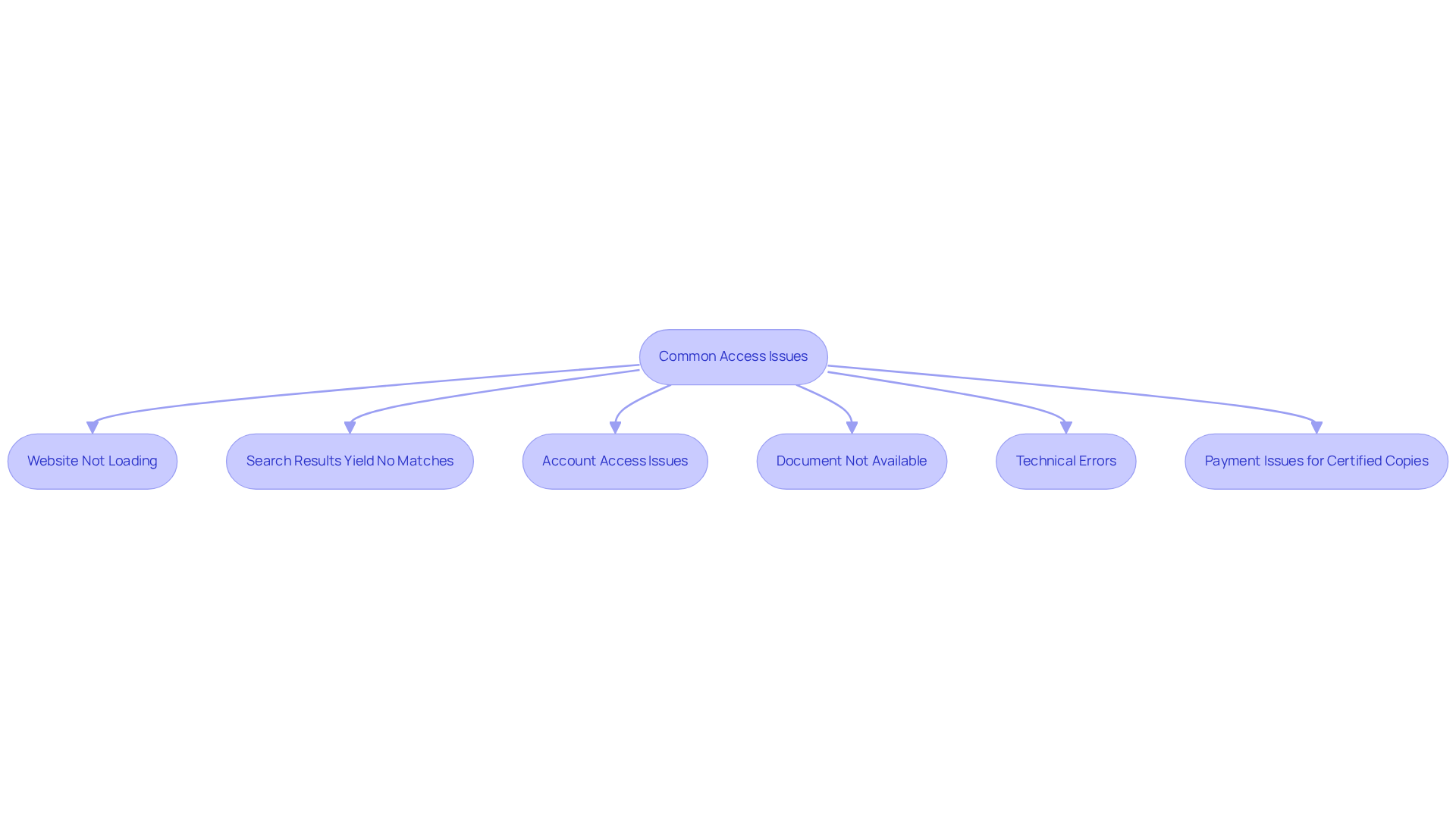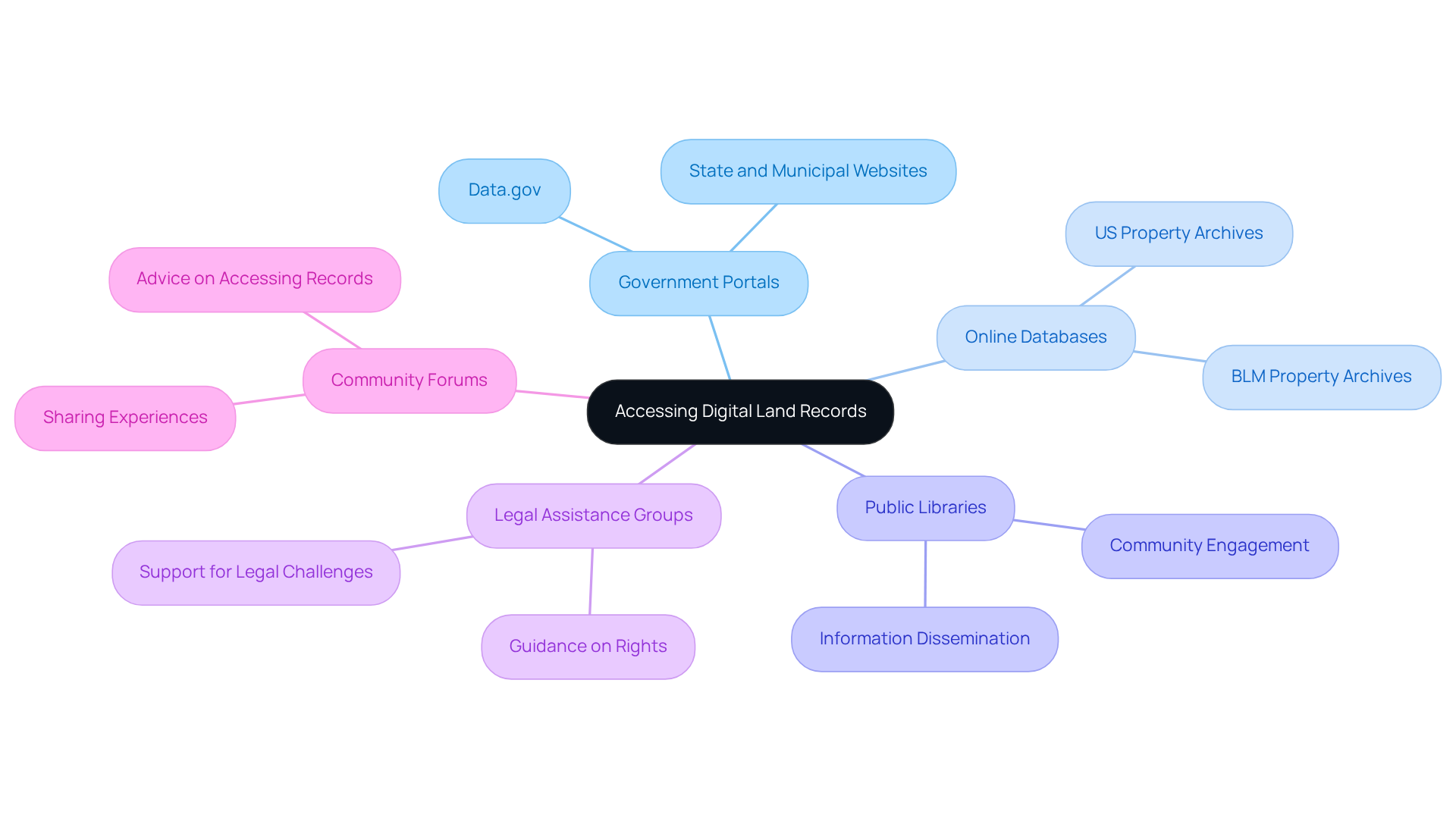Overview
Accessing digital land records is a critical process that necessitates a systematic approach. It begins with:
- Identifying the appropriate authority.
- Visiting their official website.
- Utilizing search functions to locate the desired documents.
This article provides a comprehensive step-by-step guide, underscoring the significance of understanding the necessary procedures. Furthermore, it addresses common challenges faced during this process and offers solutions to ensure efficient retrieval of property information.
Introduction
Navigating the world of property ownership has become increasingly streamlined with the advent of digital land records. These electronic documents not only enhance the efficiency of accessing vital ownership information but also safeguard against the risks associated with physical paperwork. However, the process of accessing these records can still pose challenges for many individuals.
What steps are necessary to successfully navigate the digital landscape of land records? Furthermore, how can one overcome common obstacles along the way?
Understand Digital Land Records
Digital property documents represent electronic versions of ownership papers, meticulously digitized for streamlined access and management. These files encompass deeds, mortgages, and various legal documents associated with property ownership. The transition from paper to digital formats significantly enhances the efficiency of land information management by improving how to access digital land records, facilitating quicker searches and retrievals. Furthermore, digital files mitigate the risk of loss or damage linked to physical documents, ensuring that critical data remains intact and providing information on how to access digital land records. Understanding these facets is imperative for real estate professionals who depend on for their transactions.

Access Digital Land Records: Step-by-Step Process
- Identify the appropriate authority to understand how to [access digital land records](https://blog.parseai.co/overview-of-oil-and-gas-title-services-key-components-and-evolution) by determining which governmental agency or office holds the property files for your area. This could be a county clerk, recorder's office, or a state land office.
- Visit the official website to find out how to from the identified authority. Look for sections labeled 'Land Records', 'Property Records', or 'Public Records' to understand how to access digital land records.
- Create an Account (if necessary): Some platforms may require you to establish an account to access information. Follow the prompts to register, providing necessary information such as your name, email, and any required identification.
- To find information, learn how to access digital land records by using the search function on the website. You can typically find out how to access digital land records by searching by property address, owner name, or parcel number. Enter the relevant details and initiate the search.
- Review Search Results: Once the search is complete, review the results. Click on the relevant entries to view more details about the property.
- To find out how to access digital land records, you can view or download images of the documents if they are available. Look for choices to print or save the files for your reference.
- If you require certified copies of any documents, follow the instructions provided on the website, which will also guide you on how to access digital land records, and may involve a fee.
- If you encounter any issues, most websites have a support or contact section that can guide you on how to access digital land records. Reach out for help with accessing records or resolving technical difficulties.

Troubleshoot Common Issues in Accessing Records
- Website Not Loading: If the website is unresponsive, first verify your internet connection. Attempt to access the site using an alternative browser or device. Should the issue persist, it may indicate a temporary outage or maintenance on the website's end.
- Search Results Yield No Matches: Ensure that you are entering accurate information. Double-check for any spelling errors and formatting discrepancies. When searching by address, consider employing variations or common abbreviations as part of how to to enhance your chances of locating the desired records.
- Account Access Issues: If you are unable to log in, confirm that your username and password are correct. Utilize the 'Forgot Password' feature if necessary. If access issues persist, it is advisable to contact customer support for assistance on how to access digital land records.
- Document Not Available: If a specific document is not accessible online, it may not have been digitized yet. Explore options to request physical copies or inquire about the document's digitization status through the support channels.
- Technical Errors: When encountering error messages, take note of the error code displayed. This information can be crucial when contacting the website's support team, who can provide specific guidance on resolving the technical difficulties.
- Payment Issues for Certified Copies: If you experience complications during the payment process for certified copies, ensure that your payment method is valid and that all billing details are entered accurately. If issues persist, contacting customer support is advisable.
Based on recent information, approximately 30% of users have reported login problems on property websites, underscoring the importance of having clear troubleshooting procedures readily accessible. IT experts emphasize that maintaining current contact details for assistance can significantly reduce downtime when retrieving essential data.

Utilize Additional Resources for Enhanced Access
State and municipal government websites play a crucial role in showing how to access digital land records, with many states establishing dedicated portals for this purpose. These official sites typically feature user-friendly interfaces that facilitate the search process and provide guidance on how to access digital land records, enabling individuals to easily locate necessary documents. For instance, Data.gov, which boasts nearly 300,000 datasets as of 2024, serves as a valuable resource for accessing various property documents and related information.
In addition to government portals, online databases such as US Property Archives and BLM Property Archives offer extensive collections of property documents, which can guide users on how to access digital land records across multiple jurisdictions. These platforms enhance accessibility by from the comfort of their homes.
Public libraries also contribute significantly to the dissemination of property documentation information. Many libraries provide information on how to access digital land records and employ knowledgeable staff who assist visitors in navigating these resources. Collaborations between public libraries and property documentation agencies have proven effective, fostering community engagement and improving public access to essential data, such as how to access digital land records. As noted by a librarian, public libraries function as vital centers for information, assisting individuals in comprehending how to access digital land records in an efficient manner.
Legal assistance groups are vital for individuals facing legal challenges related to property documentation. These organizations offer guidance and support, helping users understand their rights and navigate complex legal landscapes. A spokesperson from a legal assistance group stated, "Our function is to empower individuals by providing the essential resources and support to address property documentation issues."
Furthermore, community forums focused on real estate serve as valuable platforms for sharing experiences and advice on how to access digital land records. Engaging with others in these online spaces can yield insights and practical advice, enhancing the overall experience of acquiring land-related information. Additionally, the Global Real Estate Transparency Index underscores the importance of accessible land records in promoting transparency within property markets, highlighting the necessity for effective land record management.

Conclusion
Accessing digital land records is an essential process that modernizes property management and significantly enhances efficiency in real estate transactions. Transitioning from traditional paper documents to digital formats allows individuals to streamline their search for vital property information, ensuring that crucial records are easily retrievable and safeguarded against loss or damage.
This guide outlines key steps to facilitate the process of accessing digital land records:
- Identifying the appropriate governmental authority
- Utilizing online resources
- Troubleshooting common issues
Each stage is meticulously designed to empower users with the knowledge required to navigate the digital landscape effectively. Furthermore, the importance of additional resources, such as public libraries and legal assistance groups, is emphasized, showcasing the collaborative efforts that enhance access to property documentation.
Ultimately, embracing digital land records not only simplifies the retrieval of property information but also promotes transparency and efficiency within the real estate sector. Individuals are strongly encouraged to leverage the available resources and support systems to ensure they can access the necessary documents with ease. By doing so, they contribute to a more informed and accessible property management environment, which is essential for fostering trust and integrity in real estate transactions.
Frequently Asked Questions
What are digital land records?
Digital land records are electronic versions of property ownership documents, including deeds, mortgages, and other legal papers associated with property ownership.
How do digital land records improve land information management?
They enhance efficiency by allowing quicker searches and retrievals, making access to land records more streamlined compared to traditional paper formats.
What are the benefits of transitioning from paper to digital land records?
The transition reduces the risk of loss or damage to physical documents, ensuring that critical data remains intact and easily accessible.
Why is understanding digital land records important for real estate professionals?
It is crucial for real estate professionals to understand digital land records because they rely on accurate and timely information for their transactions.




